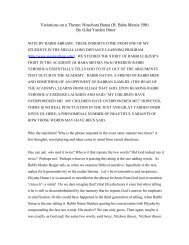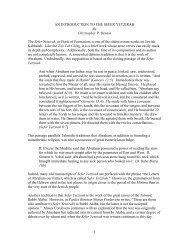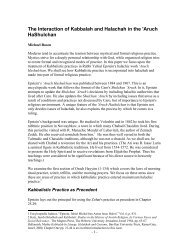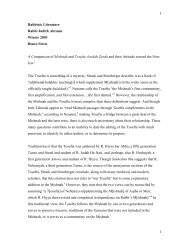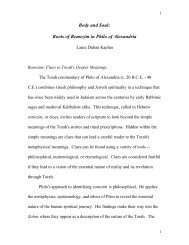The Symbolic Representation of the Sefer Torah - Maqom
The Symbolic Representation of the Sefer Torah - Maqom
The Symbolic Representation of the Sefer Torah - Maqom
You also want an ePaper? Increase the reach of your titles
YUMPU automatically turns print PDFs into web optimized ePapers that Google loves.
example, <strong>the</strong> rabbis preferred to distance <strong>the</strong> lay Jew from mystical teachings. Fur<strong>the</strong>rmore, <strong>the</strong>re weremany questions as to both <strong>the</strong> trustworthiness and credibility <strong>of</strong> <strong>the</strong> Zohar. Many rabbis felt that halakhicrulings could not be derived from <strong>the</strong> Zohar. Typical <strong>of</strong> this view was Rabbi Yichezkel Landau (1713-1793) in his work <strong>of</strong> responsas Noda B’Yehudah, who explicitly states that “we do not adjudicate from <strong>the</strong>Zohar.” 21 Different issues arose as result <strong>of</strong> this prayer being recited in Aramaic language. <strong>The</strong> BabylonianTalmud, p. 12b, teaches that one should not make requests to G-d in Aramaic because <strong>the</strong> angels whointervene between <strong>the</strong> supplicant and G-d do not understand Aramaic. Although <strong>the</strong> Talmud finds a reasonto allow Aramaic at times, making requests to G-d in Hebrew is preferable. 22 A fur<strong>the</strong>r objection wasraised by Hidah (Responsa Yosef Ometz section 44), who argued that on <strong>the</strong> Sabbath one should not makepersonal requests in prayers. 23 <strong>The</strong> Hidah provides an unclear response.Different opinions were <strong>of</strong>fered as to <strong>the</strong> day on which to recite <strong>the</strong> prayer. <strong>The</strong> Kaf Hahaim arguesthat since <strong>the</strong> prayer appears in <strong>the</strong> Zohar within <strong>the</strong> discussion <strong>of</strong> Shabbat, this is <strong>the</strong> time it should besaid. In fact, <strong>the</strong> Magen Avraham rules that Brich Shimei should only be recited on <strong>the</strong> Sabbath. RabbiChaim Yosef Abdula, known as <strong>the</strong> Ben Ish Chai, argues that since it is recited (now) on a regular basis, itis permitted to recite it on <strong>the</strong> Sabbath. 24Hamburger (1995, p. 178) cites mystics who—with thatunderstanding—argue that <strong>the</strong> prayer should only be recited during <strong>the</strong> mincha prayer on <strong>the</strong> Sabbath. Assummarized by Rabbi Israel Mayer Hacohen in <strong>the</strong> Mishnah Berurah (134:13), <strong>the</strong> majority <strong>of</strong> Ashkenaziadjudicators rule that Brich Shmei should be recited whenever <strong>the</strong> <strong>Sefer</strong> <strong>Torah</strong> is removed from <strong>the</strong> HolyArk and read.O<strong>the</strong>rs rejected <strong>the</strong> prayer because <strong>of</strong> <strong>the</strong> sentence “nor in <strong>the</strong> son <strong>of</strong> G-d do I trust” implying that<strong>the</strong>re is a son <strong>of</strong> G-d as in <strong>the</strong> Catholic dogma. 25 In his Baruch Sheamar (pp. 177-178), Rabbi Baruch21 Reponsa Noda B’Yehudah Kama Yorea Dea section 74.22 See Shulkhan Arukh 101:4 and <strong>the</strong> standard Sulkhan Arukh commentaries.23 This issue, including <strong>the</strong> views <strong>of</strong> additional rabbinical authorities, is discussed in Meller p. 22 ff. 10, Hamburger 1995, pp.176-177.24 See Responsa <strong>Torah</strong> Shelema section 103.25 <strong>The</strong> accepted explanation is that this refers to angels. <strong>The</strong> Art Scroll prayer book translates <strong>the</strong>se words “nor on any angel do Irely.” <strong>The</strong> Siddur Tzalota D’Avraham volume 1 p. 362 argues that <strong>the</strong>se words mean great strength but objected to <strong>the</strong> termangels. Rabbi Epstein in his Kitzur Hashela (p. 137) where he <strong>of</strong>fers <strong>the</strong> complete text <strong>of</strong> <strong>the</strong> prayer and changes <strong>the</strong>se words toread “not on <strong>the</strong> angles <strong>of</strong> high do we rely.”12



